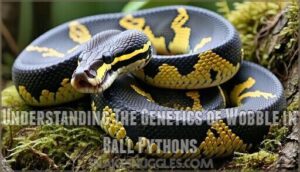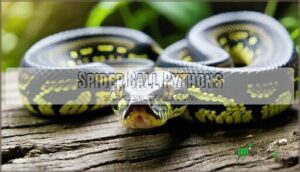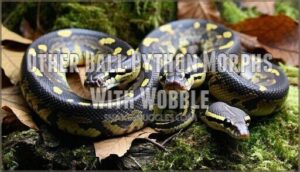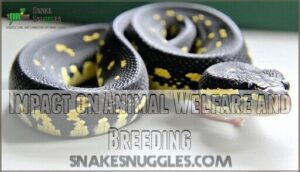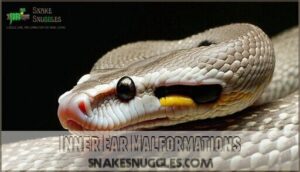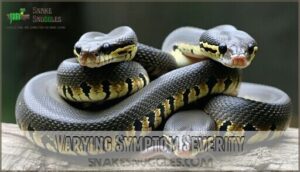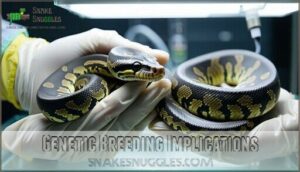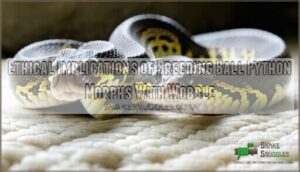This site is supported by our readers. We may earn a commission, at no cost to you, if you purchase through links.
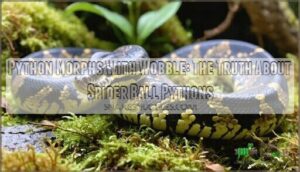
This trait can cause head tilting, erratic movements, and coordination issues, like watching a drunk uncle on roller skates.
It’s not painful, but it can vary in severity, from barely noticeable to blatantly apparent.
Spider morphs are the main culprits, though a few related morphs also carry wobble.
Breeding them is a hot topic, raising ethical questions about prioritizing appearances over health.
If you’re considering owning or breeding a python morph with wobble, understanding the responsibility is key—because reptiles deserve thoughtful care.
Table Of Contents
- Key Takeaways
- What is Wobble Syndrome in Ball Pythons?
- Understanding The Genetics of Wobble in Ball Pythons
- Identifying Python Morphs Affected by Wobble Syndrome
- Impact on Animal Welfare and Breeding
- Neurological Symptoms and Challenges Associated With Wobble
- Ethical Implications of Breeding Ball Python Morphs With Wobble
- Future Research and Implications for Responsible Ownership
- Frequently Asked Questions (FAQs)
- What ball python morphs have wobble?
- Do champagne ball pythons have a wobble?
- Do clown ball pythons have a wobble?
- Do spotnose ball pythons have wobble?
- What ball python morphs have a wobble?
- What causes wobble in ball pythons?
- Do spotnose ball pythons have a wobble?
- What is wobble syndrome in ball pythons?
- Can wobble syndrome worsen with age in ball pythons?
- Are there environmental factors that influence wobble severity?
- Conclusion
Key Takeaways
- You’ll find wobble syndrome in morphs like Spider, Champagne, Woma, and Hidden Gene Woma, caused by a genetic mutation that affects their nervous system.
- Symptoms range from mild tremors to severe corkscrewing, and stress or poor care can make it worse.
- Responsible breeding focuses on balancing stunning looks with avoiding unethical practices linked to known health issues.
- Providing stable, low-stress care helps wobble-prone morphs live comfortable, manageable lives.
What is Wobble Syndrome in Ball Pythons?
Ever heard of wobble syndrome? It’s a neurological issue commonly seen in spider ball pythons, caused by a genetic mutation.
A neurological quirk in spider ball pythons, wobble syndrome arises from genetics, blending beauty with an inherent challenge.
Symptoms vary—head tilting, corkscrewing, tremors, or striking and missing prey are common examples of symptom manifestation.
Wobble diagnosis relies on observation since no tests exist, and there’s no cure—it’s lifelong.
Condition prevalence is high among spider morphs, though severity factors differ. Some snakes handle it fine, while others struggle.
Understanding wobble causes helps guarantee ethical breeding and better care for these unique snakes.
Understanding The Genetics of Wobble in Ball Pythons
You might find it fascinating (and a bit puzzling) how Wobble Syndrome in spider ball pythons boils down to genetics. A genetic mutation tied to the spider gene disrupts nervous system development, leading to this neurological disorder.
It’s an example of pleiotropic effects—where one gene impacts multiple traits, and not always in a good way. The mutation’s origins aren’t fully understood, adding mystery to its genetic linkage. Bumblebee morphs also carry this gene.
Here’s the rundown:
- Gene mapping reveals the spider gene is a co-dominant mutation, always expressed in offspring.
- Some cases show severe wobble symptoms due to unpredictable gene interaction.
- Responsible breeding ethics demand avoiding genetic screening negligence.
- The spider gene’s traits are beautiful yet bittersweet, thanks to wobble syndrome’s impact.
Identifying Python Morphs Affected by Wobble Syndrome
You’ve probably heard that some ball python morphs, like the iconic Spider, come with a quirky twist—literally.
Identifying which morphs are affected by wobble syndrome isn’t hard once you know what to look for, and it’s key to making responsible choices.
Spider Ball Pythons
Although undeniably stunning, spider ball pythons are infamous for wobble syndrome—a neurological issue linked to their genetic mutation.
Their mesmerizing patterns and golden-green eyes make them a favorite among enthusiasts, but this beauty comes with challenges.
Here’s what stands out:
- Spider genetics: The mutation causing their distinctive look also affects neurological development, leading to the wobble syndrome.
- Spider temperament: Symptoms vary, from subtle head tilting to dramatic corkscrewing, making each snake’s condition unique.
- Spider care: These snakes require patient handling and calm environments, as stress can amplify their neurological disorder.
Despite their popularity, owning one demands understanding and a commitment to their specialized care needs.
Other Ball Python Morphs With Wobble
Did you know wobble syndrome isn’t exclusive to the spider ball python? Other ball python morphs, like the Champagne Wobble or Woma, also face neurological challenges.
Champagne morphs often exhibit mild-to-moderate wobble paired with eye defects, while Woma concerns include odd sex ratios. Hidden Gene morphs show mild wobble and congenital anomalies, whereas Super Sable and Powerball risks involve severe symptoms or genetic complications.
These neurological issues highlight the complexity of breeding and caring for such unique snakes. Reptiles may also experience issues like septicemia, a common and potentially fatal blood infection.
Impact on Animal Welfare and Breeding
Breeding wobble-prone ball pythons like Spider morphs sparks endless debates about animal welfare and ethics. Wobble syndrome isn’t just a neurological issue—it’s a hot topic challenging how breeders consider these snakes’ quality of life.
Breeding spider ball pythons raises complex questions about balancing stunning morphs with the ethical responsibility of ensuring snake well-being.
You can’t ignore genetic testing anymore; it’s the backbone of responsible breeding. Done right, it helps reduce the chances of passing on wobble traits.
Still, breeding ethics are tricky. Why? Because it’s a balancing act between preserving dazzling morphs and ensuring their well-being. Stress makes their symptoms worse, complicating this debate further.
Here’s what you should prioritize:
- Testing for genetic risks to avoid passing on the wobble gene.
- Improving care standards suited for affected snakes’ needs.
- Weighing welfare debate seriously before producing spiders.
- Understanding legal considerations, like bans in some reptile communities.
Ethics demand a shift toward putting the snake’s welfare first. A reliable test is available for breeders.
Neurological Symptoms and Challenges Associated With Wobble
You’ll notice that pythons with wobble often struggle with head tilting, tremors, or quirky movements that make feeding and coordination a real challenge.
It’s a lifelong condition tied to inner ear issues and genetics, but with proper care, they can still lead relatively comfortable lives.
Inner Ear Malformations
Inner ear malformations are behind the balance disruption seen in ball pythons with wobble syndrome.
These deformities, found in the semicircular canals, ampullae, crus communis, and sacculus, wreak havoc on the vestibular system.
Morph susceptibility, especially in spider pythons, correlates with severe sensory impact.
Micro-CT imaging revealed these deformities in detail.
- Severity Correlation: Poor coordination and head tilts stem from genetic quirks linked to selective breeding, making wobble both a fascinating study and a cautionary tale for breeders.
Varying Symptom Severity
Symptom severity in wobble syndrome isn’t one-size-fits-all.
Mild cases might show subtle head tremors, while severe wobble could lead to erratic movements, struggling with balance and coordination, or corkscrewing.
Environmental influence, like stress impact, often worsens neurological symptoms.
Head tremors in snakes can also indicate other conditions like Inclusion Body Disease.
Each snake’s response is unique due to individual variation.
Managing stress and observing for progressive worsening are key to keeping affected pythons comfortable and thriving.
Genetic Breeding Implications
Balancing unique morph creation with animal welfare isn’t simple.
Genetic mutations like those causing wobble syndrome in spider ball pythons demand careful thought.
Ethical breeding practices, gene selection, and structured screening programs can reduce mutation effects in morphs combinations.
Responsible breeding means prioritizing health over appearance, avoiding reckless pairings that risk neurological disorders.
Those seeking help can find products for wobble.
After all, healthy snakes deserve the spotlight.
Ethical Implications of Breeding Ball Python Morphs With Wobble
Addressing breeding ethics means asking tough questions about morph demand and animal welfare.
Is creating spider ball pythons with a known neurological issue fair to their quality of life?
Genetic manipulation for appearance often raises ethical implications, especially when wobble syndrome is involved.
Disclosure responsibility should always take center stage—potential owners deserve honesty.
Breeding isn’t about chasing rarity; it’s about guaranteeing generations thrive without unnecessary suffering.
Remember, your choices directly impact these animals’ futures.
Aim for compassion over curiosity.
Responsible breeders also consider appropriate habitat products to guarantee the well-being of their animals.
Future Research and Implications for Responsible Ownership
Breeding Ethics and improved welfare take center stage when thinking about future research on wobble syndrome.
Genetic research holds the promise of revealing better solutions, potentially reducing the prevalence of this neurological condition in affected morphs.
Long-term studies could reveal how certain genetic variations impact wobble severity, offering paths for more responsible breeding practices.
As an owner, you’re not just caring for a snake—you’re part of the larger effort to prioritize animal welfare.
Owner education plays a big role here.
Stay updated with neurological studies and refine your husbandry based on new findings.
Responsible ownership means asking tough questions about the ethical implications of breeding certain morphs.
Together, we can support transparent practices that benefit these fascinating creatures.
Frequently Asked Questions (FAQs)
What ball python morphs have wobble?
Spider morphs are the wobble kings, but don’t forget Champagne, Woma, Hidden Gene Woma, Super Sable, Powerball, and others.
These genetic quirks make them unique, but they’ll need extra care and understanding, as they are the wobble kings.
Do champagne ball pythons have a wobble?
Champagne ball pythons can have a mild to moderate wobble, similar to other morphs with neurological quirks.
It’s like they’re auditioning for “Dancing with the Balls” – they just move differently!
Do clown ball pythons have a wobble?
Ever wondered if clown ball pythons wobble like their spider cousins?
Don’t worry—they don’t.
Clown morphs are free of the neurological issues linked to wobble genes, making them a steady choice for enthusiasts.
Do spotnose ball pythons have wobble?
Spotnose ball pythons usually don’t have a wobble, but combining the Spotnose gene with others (like Spider or Champagne) can potentially cause wobbles.
Always research specific pairings to understand any risks before breeding.
What ball python morphs have a wobble?
Around 30% of ball python morphs, including Spider, Champagne, Woma, and Hidden Gene Woma, are prone to wobble syndrome.
It’s a genetic quirk causing wobbly movements, ranging from mild tremors to dramatic corkscrewing motions.
What causes wobble in ball pythons?
Wobble in ball pythons comes from a genetic mutation affecting the nervous system, mainly tied to specific morphs like the spider gene.
It causes balance problems, head tremors, and unpredictable movements, varying in severity.
Do spotnose ball pythons have a wobble?
Spotnose ball pythons don’t have that infamous wobble seen in spider morphs.
However, combining Spotnose with certain genes, like Spider or Champagne, can increase the likelihood of wobble, so breeding choices matter.
What is wobble syndrome in ball pythons?
Picture a snake trying to moonwalk—it’s wobble syndrome, a neurological condition in ball pythons.
It causes head tilting, tremors, and wobbly movements, thanks to a gene mutation, especially in spider morphs.
Can wobble syndrome worsen with age in ball pythons?
Yes, wobble syndrome can worsen with age in ball pythons, especially if stress or improper care adds to the neurological strain.
Keeping their environment stable and low-stress helps manage symptoms and improve quality of life.
Are there environmental factors that influence wobble severity?
Stress, improper lighting, inconsistent temperatures, and frequent handling can crank up wobble symptoms in ball pythons.
Think of it like a bad hair day—poor care makes things worse, while stable conditions help keep it manageable!
Conclusion
Strangely enough, python morphs with wobble, like Spider ball pythons, captivate enthusiasts despite their challenges.
While the syndrome isn’t painful, its impact on movement and coordination can raise ethical dilemmas when breeding.
As a potential owner or breeder, it’s your job to balance admiration for these unique morphs with their well-being.
By staying informed and prioritizing responsible care, you can help guarantee these snakes thrive.
After all, they depend on you to make thoughtful choices.
- https://wheremyscalesslither.weebly.com/the-spider-morph-and-the-wobble.html
- https://reptilesandresearch.org/articles/the-science-behind-why-spider-ball-pythons-wobble-whats-really-going-on
- https://sites.duke.edu/thewellianmag/2021/04/13/a-shaky-case-for-wobbly-snakes
- https://pmc.ncbi.nlm.nih.gov/articles/PMC9377635
- https://www.reddit.com/r/ballpython/comments/gxsbtr/which_morphs_have_the_wobble

